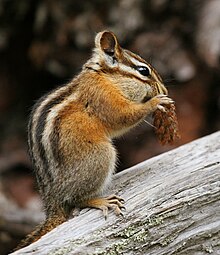Least chipmunk
| Least chipmunk | |
|---|---|
 |
|
| Scientific classification | |
| Kingdom: | Animalia |
| Phylum: | Chordata |
| Class: | Mammalia |
| Order: | Rodentia |
| Family: | Sciuridae |
| Genus: | Tamias |
| Species: | T. minimus |
| Binomial name | |
|
Tamias minimus (Bachman, 1839) |
|
| Synonyms | |
|
Neotamias minimus |
|
Neotamias minimus
Eutamias minimus
The least chipmunk (Tamias minimus) is the smallest species of chipmunk, and the most widespread in North America.
It is the smallest species of chipmunk, measuring about 15.7–25 cm (6.2–9.8 in) in total length with a weight of 25–66 g (0.88–2.33 oz). The body is grey to reddish-brown on the sides, and greyish white on the underparts. The back is marked with five dark brown to black stripes separated by four white or cream-colored stripes, all of which run from the nape of the neck to the base of the tail. Two light and two dark stripes mark the face, running from the tip of the nose to the ears. The bushy tail is orange-brown in color, and measures 10–11 cm (3.9–4.3 in) long.
As in other chipmunks, there are four toes on each of the forefeet, and five on the hindfeet. Females have eight teats. The brain to body mass ratio for least chipmunks is lower than that for other species of chipmunk living in the same area, suggesting that they prefer less complex environments.
Least chipmunks are found through the western United States from northern New Mexico and western North and South Dakota to eastern California, Oregon and Washington, and throughout much of southern and western Canada from Yukon to Ontario, and into the Upper Peninsula of Michigan and neighbouring parts of Wisconsin and Minnesota. Throughout this range, as many as 21 subspecies have been identified. Less arboreal than other chipmunks, least chipmunks are commonly found in sagebrush habitats and coniferous woodland, and along rivers, but they also occur in alpine meadows, and on the edges of the northern tundra.
Least chipmunks are diurnal and eat seeds, berries, nuts, fruits and insects. They mark areas depleted of suitable food with urine, and do not return to such patches afterwards.Home ranges vary widely, and have been reported to vary from 0.1 ha (0.25 acres) in northern Michigan to as much as 5.5 ha (14 acres) in Colorado. Because of their small size, least chimpunks are generally subordinate to yellow-pine chipmunks, which are able to drive them away from food resources where food is plentiful. However, because they need to eat less food in order to survive, least chipmunks are more numerous where resources are scarce. They are agile animals, and have been recorded running at speeds of up to 7.7 km/h (4.8 mph) in natural conditions.
...
Wikipedia

